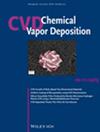Designing Non-uniform Wafer Micro-topography for Macroscopic Uniformity in Multi-scale CVD Processes†
Abstract
The potential of an additional degree of freedom (DOF) in the effort to meet film or deposition rate uniformity along the wafer in CVD processes is investigated. The investigation applies to cases of deposition on a wafer with micro-topography where the common practice is a uniform density of patterns or features (e.g., trenches or holes), with the additional DOF as the feature density along the wafer. A non-uniform density is designed with the objective of improving the uniformity; as a consequence, the differences in the profiles of the deposited films in all the features on the wafer will be compensated. A multi-scale modeling framework is utilized for the design. The case study is aluminum metal-organic (MO)CVD from dimethylethylamine alane under conditions of low macroscopic uniformity. Compared to a uniform density of the same number of trenches, the multi-scale computations predict that the designed density of features, namely trenches, induces a remarkable improvement of both the macroscopic uniformity and the number of trenches on the wafer where the uniformity exceeds 0.95. The methodology is applied to features, i.e., the simplest unit cell of topography on a wafer, even if practical implementation of the variation of feature density is difficult. The same methodology can be applied to design the density of a cluster of features comprising a single device, or a die on the wafer.

 求助内容:
求助内容: 应助结果提醒方式:
应助结果提醒方式:


